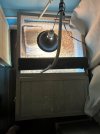Hello everyone, this is my first post here, so forgive me if I am doing it wrong! I will ask my questions and then give a little more backstory, but if you see anything that can be improved upon I am more than happy to take suggestions! I just ask that you are kind about it as I really do strive to give her the best care with what I know and have available. I have included pictures of my turtle (Jeter) and her enclosures for reference. I also mainly use the Reptifiles three-toed box turtle care sheet as that's what our veterinarian recommended, although I don't follow it exactly.
I am located in northeast Ohio and have been struggling to keep the humidity up for my box turtle. I try to mist her enclosure daily, keep a humid hide outdoors, and run a humidifier indoors all night for about 8-12 hours. However, I don't know how to increase the average humidity especially outside. Inside overnight the humidity is about 75-80% because of the humidifier, but then drops down to 50 and sometimes even lower in her basking area. Outdoors the humidity can drop to around 45% as well. My dilemma with both enclosures is that I don't want to keep the substrate constantly damp as I've heard that this can lead to serious issues like shell rot, but she has had some consistent issues with being dehydrated despite soaking in her water dishes. I'd like to mention this is the first year we've had the outdoor enclosure. I've tried to include as much information as possible on both enclosures, but feel free to request more information and pictures.
I have a second question and I'm hoping that's alright since I didn't want to make an entirely new thread, but if anyone can identify the species of box turtle I have then I would be grateful. Jeter has three toes on her back feet and five in the front. I am pretty certain she is a three-toed turtle because of this and her coloring. However, they are pretty rare around here and the vet assumed she was an Eastern box turtle. Let me know what you guys think! I can try and get more pictures of her if needed.
Here's some information on the enclosures:
Indoors: 3ft x 2ft x 1ft (I recognize this is very small, but this is the biggest enclosure I could physically fit in my home. When I move I will definitely make sure she has a properly sized indoor enclosure.)
Outdoors: 8ft x 8ft x 1.5ft
I am located in northeast Ohio and have been struggling to keep the humidity up for my box turtle. I try to mist her enclosure daily, keep a humid hide outdoors, and run a humidifier indoors all night for about 8-12 hours. However, I don't know how to increase the average humidity especially outside. Inside overnight the humidity is about 75-80% because of the humidifier, but then drops down to 50 and sometimes even lower in her basking area. Outdoors the humidity can drop to around 45% as well. My dilemma with both enclosures is that I don't want to keep the substrate constantly damp as I've heard that this can lead to serious issues like shell rot, but she has had some consistent issues with being dehydrated despite soaking in her water dishes. I'd like to mention this is the first year we've had the outdoor enclosure. I've tried to include as much information as possible on both enclosures, but feel free to request more information and pictures.
I have a second question and I'm hoping that's alright since I didn't want to make an entirely new thread, but if anyone can identify the species of box turtle I have then I would be grateful. Jeter has three toes on her back feet and five in the front. I am pretty certain she is a three-toed turtle because of this and her coloring. However, they are pretty rare around here and the vet assumed she was an Eastern box turtle. Let me know what you guys think! I can try and get more pictures of her if needed.
Here's some information on the enclosures:
Indoors: 3ft x 2ft x 1ft (I recognize this is very small, but this is the biggest enclosure I could physically fit in my home. When I move I will definitely make sure she has a properly sized indoor enclosure.)
- 100w Fluker's heat lamp and bulb.
- Considering switching to 75w?
- T5 HO 10.0 24w Reptisun UVB Bulb and Zoo Med Laboratories terrarium hood.
- The lamps are on a timer of 13 hours on, and 11 hours off.
- Coconut coir + cypress mulch substrate, about 8 inches at the deepest so she can fully bury herself if she chooses.
- There's a dish always full of clean water available.
- There is a cool side of the enclosure away from the lamps.
- I'll add some sphagnum moss to this area soon.
Outdoors: 8ft x 8ft x 1.5ft
- Cypress mulch + organic topsoil + sphagnum moss substrate.
- There is a 2ft x 2ft "dig pit" of mainly soil and larger sphagnum moss, the rest is mainly cypress mulch and fine sphagnum moss.
- She is outdoors for at least a few hours as long as it is above 75 Fahrenheit, but I always bring her in before it is dark.
- She has a large log hide and a humid hide filled with larger sphagnum moss.
- I plan to add more hides soon.
- There is one Boston fern, a dying aloe vera plant, and a hen and chick plant.
- I'll add some more Boston ferns soon.
- There's a 14in. saucer and an 8in. saucer always full of clean water on opposite ends of the enclosure.


